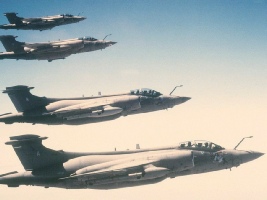All the time I had to be listening to the RWR and ready to use the ECM suite, since all the switches were in the back. With the video screen, I could immediately evaluate the results of the attack, with the experts back at base carrying out a detailed bomb-damage assessment after we landed. After the attack we immediately left the area to return to base. Unlike the Tornados, we didn't need to tank on the way home - so it was direct to Muharraq, avoiding the missile engagement zones and monitoring all the warning gear.'
This sortie set the pattern for many others and the arrival of six more Buccaneers by 8 February allowed more targets to be attacked. Lessons were learned quickly as the techniques used had never been practised before. It was the first time that the aircrew had flown in such large 'packages' with fighters, AWACS. Wild Weasels, ECM aircraft and tanker forces all flying in support of the attack formations. Needless to say, none had previously experienced listening to enemy radars triggering the RWR, nor seen surface-to-air missiles launched. The Pave Spike was a day-only system and cloud occasionally interfered with an attack, but twenty-four bridges were attacked with great success. As it became increasingly apparent that the Iraqi Air Force would not take to the air, the Sidewinders were removed from the Buccaneers and each carried a Paveway 1000lb LGB. After the Tornado attack was complete, the Buccaneers had sufficient fuel to linger in the target area and drop self-designated bombs from a forty-degree
and the arrival of six more Buccaneers by 8 February allowed more targets to be attacked. Lessons were learned quickly as the techniques used had never been practised before. It was the first time that the aircrew had flown in such large 'packages' with fighters, AWACS. Wild Weasels, ECM aircraft and tanker forces all flying in support of the attack formations. Needless to say, none had previously experienced listening to enemy radars triggering the RWR, nor seen surface-to-air missiles launched. The Pave Spike was a day-only system and cloud occasionally interfered with an attack, but twenty-four bridges were attacked with great success. As it became increasingly apparent that the Iraqi Air Force would not take to the air, the Sidewinders were removed from the Buccaneers and each carried a Paveway 1000lb LGB. After the Tornado attack was complete, the Buccaneers had sufficient fuel to linger in the target area and drop self-designated bombs from a forty-degree  dive attack before departing directly back to base. A real multi-role capability! To ensure a igher probability of success, tactics were devised to drop bombs from a sixty-degree dive.
dive attack before departing directly back to base. A real multi-role capability! To ensure a igher probability of success, tactics were devised to drop bombs from a sixty-degree dive.
As the success of the interdiction war grew and the number of bridges decreased, the LGB attacks transferred, on 12 February, to destroying Iraqi Air Force installations. The Tornados and Buccaneers were tasked to destroy hardened aircraft shelters, petroleum sites, weapon storage dumps and hangars. Later in the month, the Tornados started to receive the Thermal Imaging Airborne Laser Designators (TIALD) for self-designation and this released the Buccaneers to add their own considerable weight of bombs to the counter-air campaign. As the day for the beginning of the ground war approached, there was a fear that the Iraqi Air Force might make one last attempt to influence the war.
As a result, the southern airfields were targeted and the Buccaneers made a major contribution. Perhaps the most noteworthy of these was an opportunity attack on 27 February, the last day of operations, at Shayka Mazhar airfield.









